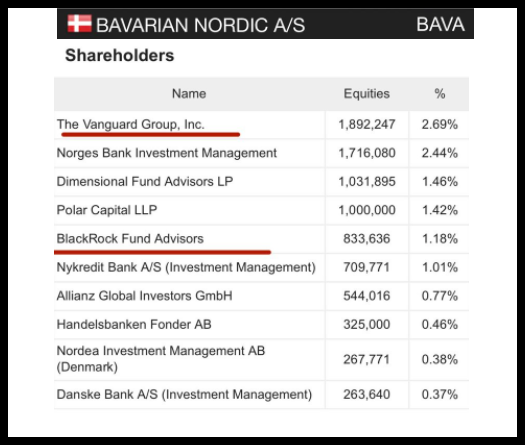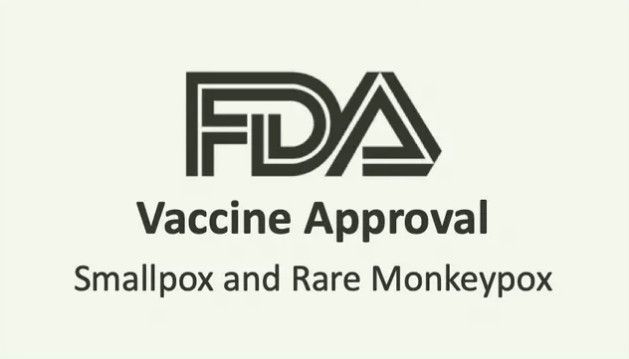The spread of monkeypox has boosted the shares of a Danish biotech company called Bavarian Nordic A/S, which say it’s the only one to make a vaccine approved for the viral infection.
According to CEO Paul Chaplin, Bavarian Nordic has already recieved requests from dozens of countries who are seeking the vaccine and confimred the company had secured a contract to supply the shot to an unnamed country in Europe.
“Monkeypox” – who could have seen that coming?
Well take a look at who funded Bavarian Nordic…. none other than Dr Anthony Fauci

And look at some of the shareholers…notably Vanguard and BlackRock.

Dr Sam Bailey reports: As with COVID-19 it appears that other parties have also been eagerly awaiting a market such a “pandemic” would present. Likewise, these fortune-tellers were preparing vaccines to go where no vaccine had gone before. In this case the biotech company Bavarian Nordic gained approval from the FDA in 2019 to market JYNNEOS, a smallpox and monkeypox vaccine. Other health authorities were also primed to react to a previously rare condition that has been of no concern for their nations…until now apparently. For example, on May 20, 2022, the UK Health Security Agency published a document titled, “Recommendations for the use of pre and post exposure vaccination during a monkeypox incident.” Like COVID-19, it’s starting to feel like all roads lead to vaccines again…

So now that the scene has been set we can get into the “science” of monkeypox starting with an official description of the alleged viral disease. The CDC states that, “Monkeypox was first discovered in 1958 when two outbreaks of a pox-like disease occurred in colonies of monkeys kept for research, hence the name ‘monkeypox.’ The first human case of monkeypox was recorded in 1970 in the Democratic Republic of Congo.” They go on to state that, “in humans, the symptoms of monkeypox are similar to but milder than the symptoms of smallpox.” The illness is said to be flu-like with the addition of lymph node swelling and then development of a rash, and then lesions that progress from macules to vesicles to scabs.
In terms of the lethality of monkeypox, the CDC state that, “in Africa, monkeypox has been shown to cause death in as many as 1 in 10 persons who contract the disease.” This 10% fatality rate has already stoked the fear narrative and was also used as the case fatality rate in the NTI’s monkeypox pipe dream. It should be noted that historically monkeypox has been virtually unheard of in first world countries and the rare cases are usually in people that have recently arrived from Africa.
Indeed, one of the only recorded “outbreaks” of monkeypox in the first world was in the United States in April 2003. Cases were declared in 6 states and said to be caused by rodents that were imported to Texas from Ghana. This was the first time monkeypox had been reported outside of Africa and the CDC published a paper in 2006 analysing the incident. The paper states that, “person-to-person spread of the virus is thought to occur principally via infectious oropharyngeal exudates” although it is clear that this has never been scientifically established. They continue to say that, “the virus is thought to have been transmitted from African animals” – in other words, it’s another species-jumping pathogen tale.
They reported that, “individuals who had illness onset within 21 days after exposure to MPXV [Monkeypox virus] who experienced fever (defined as a body temperature greater 37.4°C) and vesicular pustular rash or rash (potentially uncharacterized) plus orthopox IgM antibodies were classified as having probable cases of infection.” Now 37.4°C is not a fever in our book, it is a normal body temperature and we would suggest 37.6°C and above qualifies as a fever. We noted in their chart that they were using the classification ≥39.4°C, but this appears to be an error as in another paper, we’ll get to soon, it was once again 37.4°C. The second paper even said the “fever” could be subjective, so they appear to be using this loose criteria and pathologising a normal state. Additionally, the CDC’s weekly report from the 11th of July 2003, stated that from a total of 71 cases, only “two patients, both children, had serious clinical illness; both of these patients have recovered.” The remainder had a variety of respiratory and gastrointestinal symptoms.
The CDC’s cases were confirmed on the basis of specimens that showed, “monkeypox virus isolation, detection of monkeypox-specific nucleic acid signatures, positive electron-microscopy findings, or positive immunohistochemical findings.” We had a look at the electron micrographs presented by the CDC including the image shown below of a skin sample from one of the patients. The caption informs us that the round particles on the right are immature monkeypox virions, while the oval particles on the left are mature viruses. However, all they have is a static image of dead tissue and no conclusions can be made about the biological role of the imaged particles. None of them have been shown to be replication-competent disease-causing intracellular parasites and so should not be called ‘viruses’.
Continue reading here
by Niamh Harris
Join: 👉 https://t.me/acnewspatriots
The opinions expressed by contributors and/or content partners are their own and do not necessarily reflect the views of AC.NEWS
Disclaimer: This article may contain statements that reflect the opinion of the author. The contents of this article are of sole responsibility of the author(s). AC.News will not be responsible for any inaccurate or incorrect statement in this article www.ac.news websites contain copyrighted material the use of which has not always been specifically authorized by the copyright owner. We are making such material available to our readers under the provisions of “fair use” in an effort to advance a better understanding of political, health, economic and social issues. The material on this site is distributed without profit to those who have expressed a prior interest in receiving it for research and educational purposes. If you wish to use copyrighted material for purposes other than “fair use” you must request permission from the copyright owner. Reprinting this article: Non-commercial use OK. If you wish to use copyrighted material for purposes other than “fair use” you must request permission from the copyright owner.
Disclaimer: The information and opinions shared are for informational purposes only including, but not limited to, text, graphics, images and other material are not intended as medical advice or instruction. Nothing mentioned is intended to be a substitute for professional medical advice, diagnosis or treatment.





















![Tucker Carlson Released an ALARMING Message … [Published Yesterday]](https://ac.news/wp-content/uploads/2024/04/download-3-120x86.jpg)
























Discussion about this post